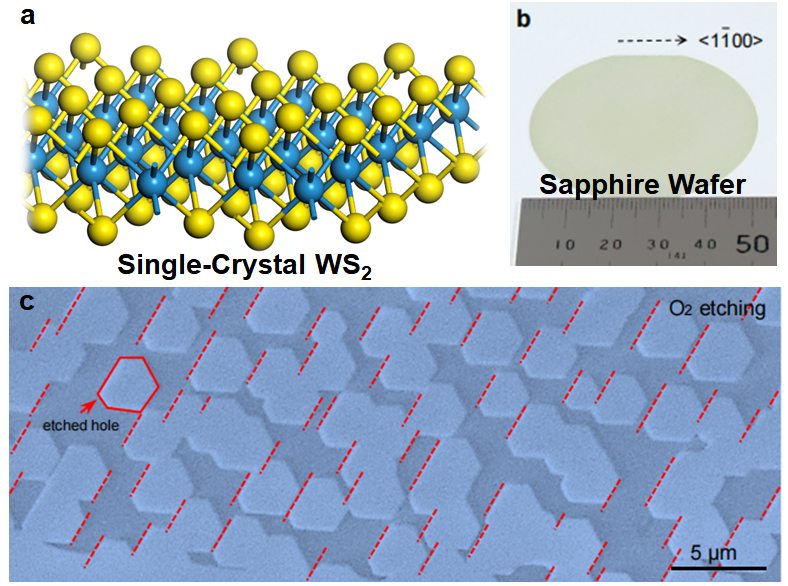With silicon-based semiconducting technology reaching its maximum limit of performance, new materials that may substitute or partially substitute silicon in technology are highly anticipated.
 a. Single-crystal WS2; b. Sapphire wafer used in industry is a single-crystal; c. Experimental images about the WS2 films on sapphire wafer after O2 etching. ((Image Credit: Institute for Basic Science).
a. Single-crystal WS2; b. Sapphire wafer used in industry is a single-crystal; c. Experimental images about the WS2 films on sapphire wafer after O2 etching. ((Image Credit: Institute for Basic Science).
In recent times, the advent of graphene and other two-dimensional (2D) materials provides a new platform for developing advanced semiconducting technology. Transition metal dichalcogenides (TMDs), such as MoS2, WS2, WSe2 and MoSe2 are part of that group, which are considered to be the most interesting 2D semiconductors.
A prerequisite for developing ultra-large-scale high-performance semiconducting circuits is that the base materials have to be a single-crystal of wafer-scale, same as the silicon wafer used at present. Although plenty of effort has been devoted to the building of wafer-scale single-crystals of TMDs, the success was very minimal until now.
Renowned Professor Feng Ding and his research team from the Center for Multidimensional Carbon Materials (CMCM), within the Institute for Basic Science (IBS) at UNIST, in partnership with scientists from Peking University (PKU), Fudan University and Beijing Institute of Technology, described the direct growth of 2-inch single-crystal WS2 monolayer films a short while ago.
In addition to the WS2, the team also showed the development of single-crystal MoS2, WSe2 and MoSe2 in wafer scale.
The core technology of epitaxially grown a large sing-crystal is to guarantee that all small single-crystal grown on a substrate are evenly aligned. Since TMDs possess a non-centrosymmetric structure or the mirror image of a TMD with regard to an edge of it has an opposite alignment, such symmetry must be broken by carefully designing the substrate.
According to theoretical calculations, the researchers suggested a mechanism of “dual-coupling-guided epitaxy growth” for experimental design. The WS2-sapphire plane interaction is the primary driving force, resulting in two desired antiparallel alignments of the WS2 islands.
The coupling between WS2 and sapphire step-edge is the next driving force, and it will break the degeneracy of the two antiparallel alignments.
Then, all the TMD single crystals grown on a substrate with step edges are unidirectional oriented. Finally, the coalescence of these small single-crystals results in a large single-crystal of the same size as the substrate.
This new dual-coupling epitaxy growth mechanism is new for controllable materials growth. In principle, it allows us realize to grow all 2D materials into large-area single crystals if proper substrate was found.
Dr. Ting Cheng, Study Co-First Author
“We have considered how to choose proper substrates theoretically. First, the substrate should have a low symmetry and, secondly, more step edges are preferred,” Professor Feng Ding, the study’s corresponding author highlights.
This is a major step forward in the area of 2D materials based device. As the successful growth of wafer-scale single-crystal 2D TMDs on insulators beyond graphene and hBN on transition metal substrates, our study provide the required keystone of 2D semiconductors in high-end applications of electronic and optical devices.
Professor Feng Ding, Study Corresponding Author, Center for Multidimensional Carbon Materials, Institute for Basic Science, UNIST
Journal Reference:
Wang, J., et al. (2021) Dual-coupling-guided epitaxial growth of wafer-scale single-crystal WS2 monolayer on vicinal a-plane sapphire. Nature Nanotechnology. doi.org/10.1038/s41565-021-01004-0.